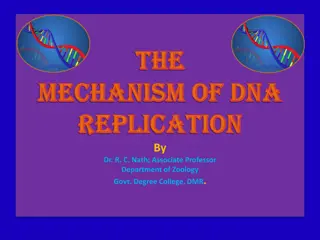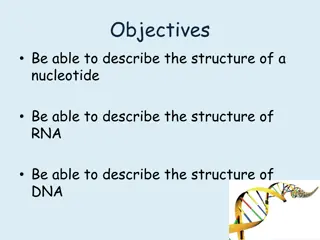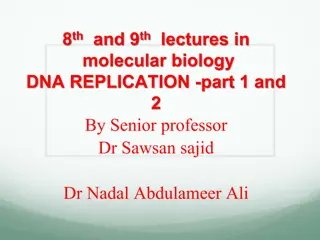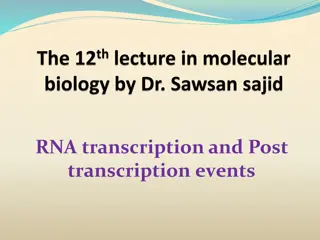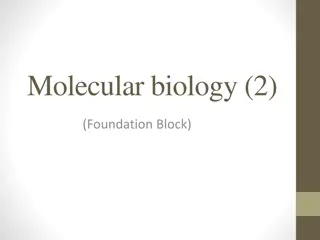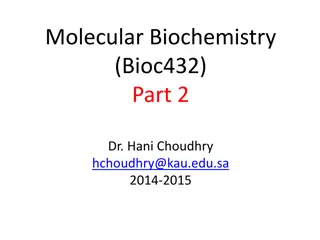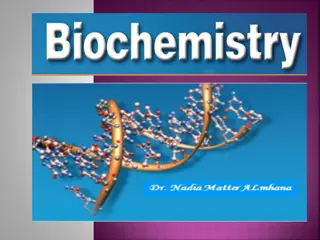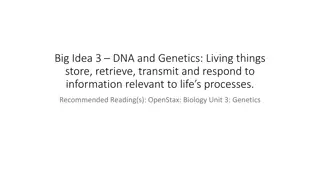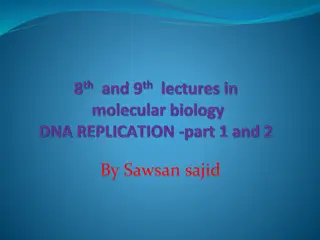Understanding DNA Structure and Replication
Discover the key aspects of DNA, including its structure as a nucleic acid polymer composed of nucleotides and the process of DNA replication. Learn about the double helix structure, base pairing rules, and the semi-conservative replication mechanism. Explore how DNA is synthesized in a 5 to 3 direction, with energy derived from nucleotide bond cleavage.
Download Presentation

Please find below an Image/Link to download the presentation.
The content on the website is provided AS IS for your information and personal use only. It may not be sold, licensed, or shared on other websites without obtaining consent from the author. Download presentation by click this link. If you encounter any issues during the download, it is possible that the publisher has removed the file from their server.
E N D
Presentation Transcript
-Bio Lab - DNA Structure & DNA Replication
What is DNA? DNA is a Nucleic Acid in the nucleus Polymer of Nucleotides Each nucleotide consists of Deoxy ribose (5-carbon sugar) Phosphate group a nitrogen-containing base Four bases (Purines)Adenine, Guanine and (Pyrimidines) Thymine, Cytosine
The scientists discovered that DNA was some sort of helix like Watson-Crick Model showed that DNA consists of two nucleotide strands: Double Helix Strands run in opposite directions - Antiparallel Strands are held together by hydrogen bonds between bases A binds with T and C with G The sides of the ladder are a sugar-phosphate backbone, while the rungs of the ladder are the bases.
Base-pairing rule The four bases of DNA are: Adenine (A) Guanine (G) Thymine (T) Cytosine (C) Adenine always hydrogen bonds with Thymine (A-T) Guanine always hydrogen bonds with Cytosine (G-C) These bonding patterns are called base pairings (bp)
DNA Replication Before mitosis and meiosis, all of the DNA in the cell must be copied or replicated How does this happen?
The mechanism by which DNA is replicated is considered semi-conservative Semi-conservative replication: Half of the original parent DNA molecule is conserved in each of the daughter molecules. This allows for the parent DNA to serve as a template for generating the daughter DNA molecules Half of the replicated DNA strand is old and the other half is new
new old old new
DNA is synthesized 5 to 3 Energy for synthesis comes from the removal of the two phosphates of the in coming nucleotide. Because DNA is antiparallel, synthesis occurs in opposite directions.
Features of replication Semi-conservative process Initiation at specific origins Replication movement usually bidirectional Strands elongated 5 to 3 Semi-discontinuous
Basic requirements for replication 1- Template (both strand of parental DNA) 2- Nucleotides (dATP, dTTP, dGTP, dCTP) 3- Enzymes: DNA polymerase, Helicase, Primase and Ligase. 4- RNA primer 5- Proteins: Single strand binding proteins (SSB).
The replication is from 5 to 3 direction of the two strands, one strand is synthesized continuously (5 to 3 ) in the direction of movement of the replication fork called leading strand ; while the other strand is synthesized discontinuously away from the movement of the replication fork in short fragments called Okazaki fragments and its strand called the lagging strand
DNA Replication steps: The chromosome of a prokaryote is a circular molecule of DNA. Replication begins at oneorigin of replication and proceeds in both directions around the chromosome. There are three steps includes: 1. Initiation: Replication begins at an origin. 2. Elongation: New strands of DNA are synthesized by DNA polymerase. 3. Termination: Replication is terminated. 17


